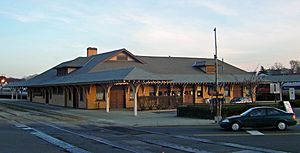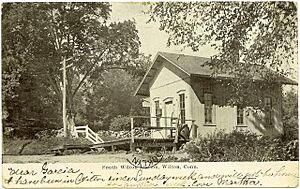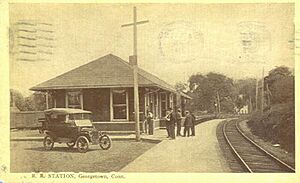Danbury and Norwalk Railroad facts for kids
 |
|
| Overview | |
|---|---|
| Current operator | Metro-North Railroad (passenger) Housatonic Railroad (freight) Providence and Worcester Railroad (freight) |
| Headquarters | Danbury |
| Locale | Danbury, CT to Norwalk, CT |
| Dates of operation | 1852–1887 |
| Successor | Housatonic Railroad |
| Technical | |
| Track gauge | 4 ft 8 1⁄2 in (1,435 mm) standard gauge |
The Danbury and Norwalk Railroad (D&N) was an important American railway company. It operated trains between the cities of Danbury and Norwalk, Connecticut. The D&N ran from 1852 until it became part of the Housatonic Railroad in 1886. Today, the same railway path is still used by the Danbury Branch of the New Haven Line of the Metro-North Railroad.
Contents
History
Fairfield County Railroad: The Early Idea (1835-1850)
The idea for the Danbury and Norwalk Railroad began in May 1835. It was first called the Fairfield County Railroad. The main goal was to build a railway from Danbury to Long Island Sound. This would help Danbury connect better with other places.
A professor from Yale University, Alexander C. Twining, studied different routes. He suggested following the Norwalk River through Norwalk and South Norwalk. This route would end at Belden's Point on Long Island Sound. Even though it was longer, it meant less travel over water to get to New York City. This made the total trip faster.
At first, the railroad was planned for horse-drawn cars. This was a big improvement over bumpy dirt roads. A horse-drawn train could go from Danbury to Norwalk in about 3 hours. A coach took half a day!
However, it was hard to get enough money for the project. People looked north of Danbury, along the Housatonic River, for more ways to fund the railroad. In 1836, the Housatonic Railroad was started in Bridgeport. Danbury was offered a chance to invest, but they said no. The Housatonic Railroad then built its tracks, going around Danbury.
Building the Danbury and Norwalk Railroad (1850-1852)
On May 29, 1850, the Fairfield County Railroad's plan was approved again. But this time, its name changed to the Danbury and Norwalk Railroad. On June 7, 1850, the company officially started with Eli T. Hoyt as its president.
The chosen route from Danbury to Norwalk was built. It connected to the New York & New Haven railway in South Norwalk.
Construction began in the fall of 1850. Workers mostly built the line from south to north. They followed the Norwalk River closely to avoid steep hills. This was important because steep hills would limit the size of trains. Because the tracks were so close to the river, the line sometimes flooded. Big floods happened in 1853, 1854, and 1955, closing the line for a short time.
Many of the workers building the railroad were Irish immigrants. They used hand tools and a few animals. They didn't use explosives to clear rocks.
The railroad officially opened for regular service on February 25, 1852. Each day, two trains ran in each direction: one for both passengers and goods, and one just for passengers. The railroad was successful, earning a good profit in its first year.
With the new railroad, travelers from Danbury could reach New York City much faster. It took the same amount of time as a stagecoach used to take just to get to South Norwalk.
Growth and Changes (1853-1872)
The D&N added more passenger trains because it was making good money. It didn't have much competition along its route. This meant trains could go slower, but profits were high.
In 1862, a new company called the Norwalk Horse Railway Company started. This company connected South Norwalk with Norwalk using horse-drawn cars. This took away some of the D&N's customers. The D&N tried to compete by putting boards between its tracks for horse-drawn carriages. But the horse railway was very popular because it had more frequent trips, lower prices, and more stops. The D&N soon stopped its horse-drawn service.
In 1864, Edwin Lockwood became president of the D&N. The Lockwood family owned a lot of shares in the railroad. They thought about building a line from Danbury to Brookfield. This would have given the D&N an important connection. However, another railroad, the New York, Housatonic and Northern Railroad, was already building a line there.
In 1869, construction began on a branch line from Branchville to Ridgefield. This 4-mile branch was hard to build because of the steep climb to Ridgefield. The first trains ran on June 25, 1870.
In 1872, another branch started being built between Bethel and Hawleyville. This branch allowed connections with other railroads, like the Shepaug, Litchfield and Northern Railroad and the Housatonic Railroad. There were even plans for the D&N to be a link in a railroad connecting New York and Boston. But these plans ended when LeGrand Lockwood, a major financial supporter, passed away in 1872.
Modernizing and Being Taken Over (1872-1886)
By 1873, the railroad had six locomotives, all running on coal. The D&N kept its tracks and equipment in good condition, even during tough economic times. They replaced old iron rails with stronger steel rails. They also improved the branch lines. By 1879, all passenger cars had modern air brakes.
In 1880, the railroad bought land in Redding. This area was already used for religious camps. The D&N promoted it as a nice place for a day trip. Many passengers came to this summer resort on regular trains. The main line had three passenger trains and one freight train in each direction daily. The Ridgefield Branch had three trips.
An extra train also started running between Bethel and Danbury. This helped many people who lived in Bethel but worked in factories near the Danbury rail yard.
In 1881, James W. Hyatt became president. Plans began to build the final part of the line from South Norwalk to Belden's Point. This would give the railroad a direct connection to New York City and other places along the Sound using ferries. The pier opened on July 4, 1882. This new pier greatly increased traffic on the line, with trains running 24 hours a day.
The new pier made the D&N a very attractive railroad for other companies to buy. On October 1, 1886, the D&N became the Danbury & Norwalk Division of the Housatonic Railroad. This happened through a 99-year lease.
After the Takeover (1886 and Later)
The Housatonic Railroad upgraded the tracks between Hawleyville and Bethel with steel. Housatonic trains then started going towards Wilsons Point instead of Bridgeport. The D&N division became busier each year.
On July 21, 1892, the New York, New Haven and Hartford Railroad (NYNH&H) took over the Housatonic Railroad. The D&N was then leased to the NYNH&H. Eventually, the NYNH&H fully owned the D&N. The NYNH&H later merged into Penn Central in 1969.
Today, the Connecticut Department of Transportation owns the old D&N line. Freight service is provided by the Providence and Worcester Railroad and a new Housatonic Railroad. Since 1983, the D&N line has been known as the Danbury Branch of the Metro-North Railroad's New Haven Line.
Routes
Main Line

Here are the main stops from south to north:
| Stop | Type | Opened! Description | |
|---|---|---|---|
| Wilsons Point | Station | July 1882 | A pier for transferring to ferries going to Oyster Bay, NY. |
| South Norwalk | Station | 1848 | A place to switch to the New York and New Haven Railroad (later the New York, New Haven and Hartford Railroad). |
| Norwalk/Wall Street | Station | 1852 | Often called "Wall Street" station. |
| Winnipauk | Station | 1852 | Located south of today's Merritt 7. |
| South Wilton | Station | 1852 | Was known as "Kent" until 1886. |
| Wilton | Station | 1852 | The original station building was moved and is now an office. |
| Cannon/Cannondale | Station | 1852 | The station built after the original burned down in 1891 is still used today. |
| Georgetown | Station | 1852 | The Gilbert and Bennett wire company was a big customer for freight here. |
| Branchville/Ridgefield | Station | 1852 | This was where the branch line to Ridgefield started. |
| Sanford/Sanford's station | Flag stop | 1852 | A "flag stop" means the train only stopped if someone waved a flag or wanted to get off. Later known as Topstone. |
| Redding | Station | 1852 | |
| Bethel | Station | 1852 | The starting point for the Hawleyville branch line in 1872. |
| Danbury | Union station | 1852 | A place to connect with the New York and New England Railroad and the Housatonic Railroad. |
Ridgefield Branch
The Ridgefield branch opened on July 1, 1870. It ran from Branchville on the main line to Ridgefield. It also had two "flag stops" (where trains stopped only if needed) at Florida and Cooper. Trains usually had two cars: one for passengers and one for baggage, express, and mail. Freight cars were added when needed.
Passenger service on the Ridgefield Branch stopped in 1925. The branch was still used for freight until 1964. Later, this railway path was turned into the Ridgefield Rail Trail, a path for walking and biking.
Hawleyville Branch
The Hawleyville branch had only one siding (a short track for trains to wait). At Hawleyville, trains could connect with the New York and New England Railroad. This connection was in addition to the one at Danbury. At Hawleyville, you could also connect to the rest of the Housatonic Railroad and the Shepaug, Litchfield and Northern Railroad.
The Hawleyville Branch was closed by the NYNH&H in 1911. It was one of the first lines the railroad stopped using.





